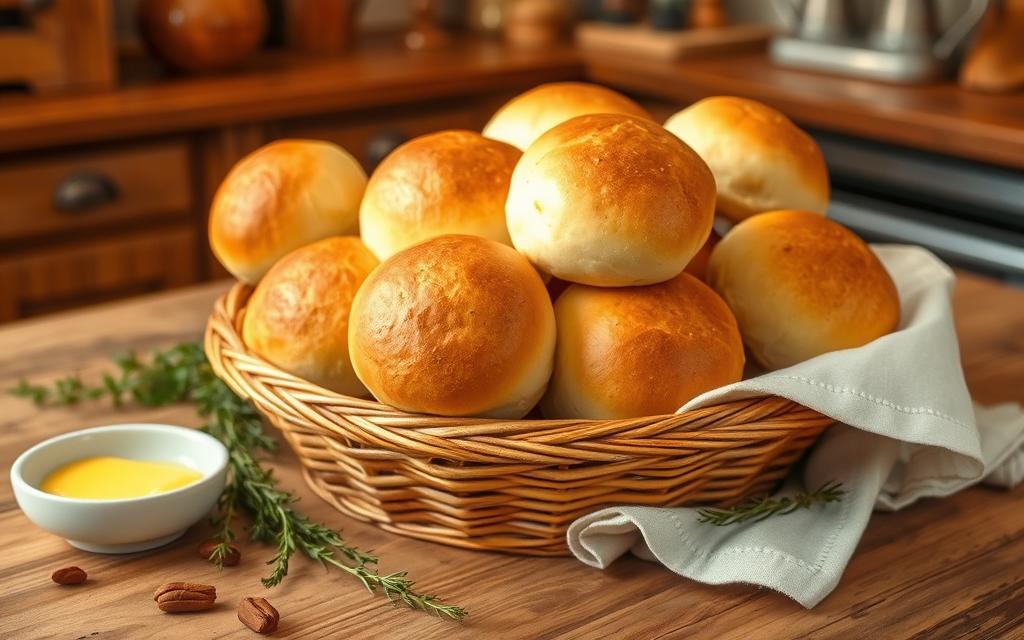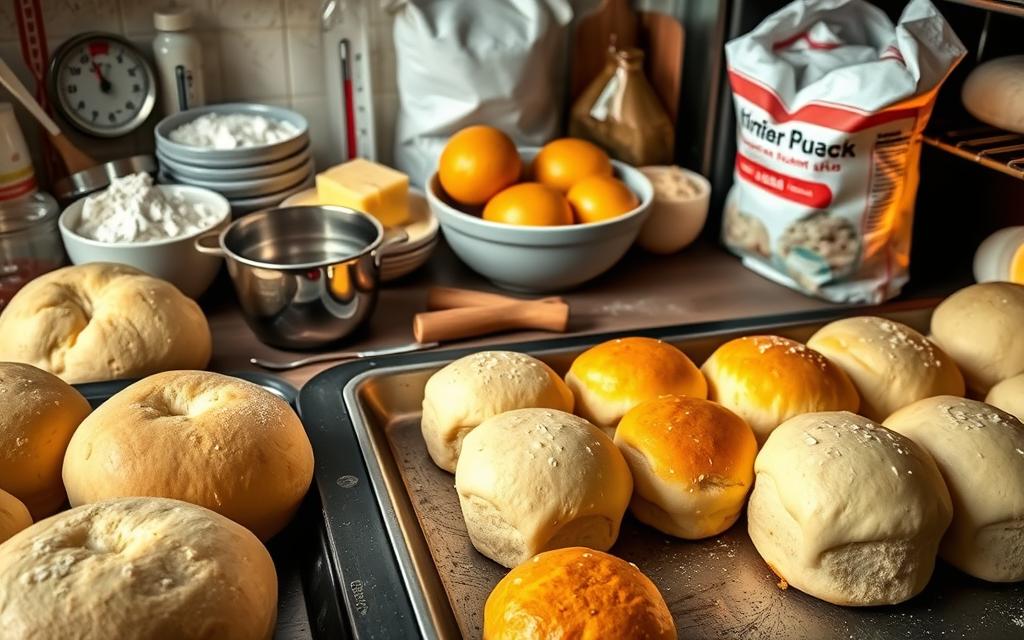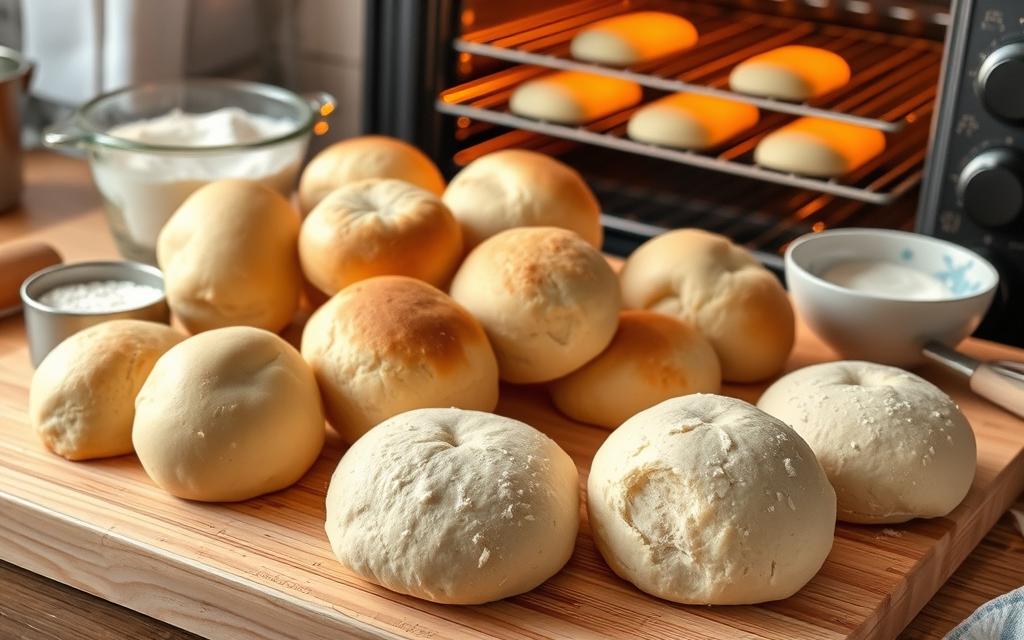When baking dinner rolls, you want them to be light and fluffy. But sometimes, they end up dense. This leaves you wondering why your dinner rolls aren’t as fluffy as you hoped. If you’re having trouble with your dinner rolls, you’re not alone.
Many people struggle with this issue. It’s often caused by a mix of ingredients, technique, and equipment. In this article, we’ll dive into Rhodes dinner rolls. We’ll also share tips to help you make your dinner rolls fluffy and perfect.
Key Takeaways
- Understanding the ingredients and technique used in Rhodes dinner rolls can help you troubleshoot common issues.
- Dinner rolls troubleshooting often involves identifying the cause of density or lack of fluffiness.
- Fluffy dinner rolls tips can help you achieve the perfect texture and make your baking experience more enjoyable.
- Why are my dinner rolls not light and fluffy is a common question that can be answered by examining your ingredients and technique.
- Dinner rolls troubleshooting requires patience and practice to get it right.
- With the right techniques and ingredients, you can make light and fluffy dinner rolls that will impress your family and friends.
Understanding Gluten-Free Diets
Gluten-free diets are about avoiding certain proteins in grains. These proteins are found in wheat, barley, and rye. Knowing about gluten is key when making dinner rolls lighter or fixing their texture.
Gluten can be hard for those with intolerance or sensitivity. It’s also good for those who choose a gluten-free life. To get the right texture, you need the right ingredients and techniques.
Going gluten-free can reduce inflammation and improve digestion. It can also boost your energy. Knowing what gluten is and how it affects you is the first step to a healthier life.
Here are some key points to consider when adopting a gluten-free diet:
- Read labels carefully to identify gluten-free products
- Explore alternative grains, such as rice, quinoa, and corn
- Learn how to make gluten-free versions of your favorite foods, such as dinner rolls
Being aware of gluten helps you make better choices. It leads to a healthier, more balanced diet. Whether for health reasons or personal preference, understanding gluten-free diets is a great start.
| Gluten-Free Grains | Gluten-Containing Grains |
|---|---|
| Rice | Wheat |
| Quinoa | Barley |
| Corn | Rye |
Overview of Rhodes Dinner Rolls
Rhodes dinner rolls are loved by many for their soft and fluffy texture. To get this texture right, you need to use the correct flour and yeast. Also, learning how to avoid dense rolls is key. With the right tips, you can make dinner rolls that everyone will love.
Some common types of Rhodes dinner rolls include:
- Classic white dinner rolls
- Whole wheat dinner rolls
- Sourdough dinner rolls
The ingredients for Rhodes dinner rolls are simple: flour, yeast, salt, sugar, and water. By following a good recipe and using the right techniques, you can make delicious, fluffy dinner rolls. These are great for any meal.
If you want to get better at baking, there are many resources out there. You can find online tutorials and baking classes. With practice and patience, you can make amazing dinner rolls that everyone will enjoy.
| Type of Dinner Roll | Ingredients | Tips and Tricks |
|---|---|---|
| Classic White | Flour, yeast, salt, sugar, water | Use warm water and let the dough rise for at least an hour |
| Whole Wheat | Whole wheat flour, yeast, salt, sugar, water | Use a combination of whole wheat and all-purpose flour for a lighter texture |
| Sourdough | Sourdough starter, flour, salt, water | Let the dough rise for at least 24 hours to develop the sourdough flavor |
Are Rhodes Dinner Rolls Gluten Free?
Many people wonder why are my dinner rolls not light and fluffy. Let’s explore Rhodes dinner rolls and their gluten-free options. Rhodes is a well-known brand with various dinner roll products, including gluten-free ones.
Identifying gluten-free dinner rolls is key. Here are some dinner rolls troubleshooting tips to help you choose the right ones:
- Check the ingredient list for gluten-free certification
- Look for products made with gluten-free flours, such as rice or almond flour
- Be aware of cross-contamination risks in the manufacturing process
Current Product Offerings
Rhodes has a variety of gluten-free dinner rolls, including frozen and baked ones. Their gluten-free products use high-quality ingredients. They are designed to be fluffy dinner rolls tips for those with gluten intolerance or sensitivity.

How to Identify Gluten-Free Options
To get a gluten-free product, always check the packaging for certification. Also, look for ingredients known to be gluten-free. By following these tips and choosing the right products, you can enjoy delicious and fluffy dinner rolls that meet your dietary needs.
Understanding Cross-Contamination
When baking gluten-free dinner rolls, it’s key to know about cross-contamination. This happens when gluten-free items touch gluten. This can be through shared tools, utensils, or even in the air.
To avoid cross-contamination, you must take steps. Use separate tools for gluten-free baking. Also, clean and sanitize all surfaces and tools well. These actions help keep your gluten-free dinner rolls safe.
Improving dinner roll texture and fixing dense ones needs the right ingredients and methods. Making dinner rolls light and fluffy takes practice and patience. But, with the right approach, you can make delicious and safe gluten-free dinner rolls.
For better dinner roll texture, mix different gluten-free flours. Add xanthan gum or guar gum for texture. Use the right amount of yeast. Follow these tips and avoid cross-contamination to make tasty and safe gluten-free dinner rolls.
Reading Labels: Key Information
When you’re looking for gluten-free dinner rolls, it’s important to read labels carefully. This helps you choose the right products for light and fluffy dinner roll tips. Knowing what to look for on the label is key.
Start by checking the ingredient list. This part of the label tells you what’s in the product, including any allergens. Understanding the ingredients helps you troubleshoot dense dinner rolls and make better choices.
- Ingredient list
- Allergen information
- Certifications, such as gluten-free certification
By considering these points and using airy dinner roll techniques, you can make better choices. This leads to the best results for your gluten-free baking.
Baking Your Own Dinner Rolls
Baking your own dinner rolls is fun and rewarding. You can pick the ingredients to fit your diet. If your rolls aren’t light and fluffy, it might be the flour or yeast.
By making your own, you can try different ingredients and methods. This way, you can get the perfect texture for your rolls.
When you’re dinner rolls troubleshooting, think about the recipe and how you bake them. Mistakes like overmixing or not letting the dough rise enough can mess up your rolls. But with practice and patience, you can make fluffy dinner rolls for any meal.
Benefits of Homemade Rolls
- Control over ingredients
- Customization of flavors and textures
- Cost-effective compared to store-bought rolls
Simple Gluten-Free Roll Recipes
Start with a gluten-free flour blend and a simple yeast recipe. Online, you can find fluffy dinner rolls tips. Try using tapioca, coconut flour, and eggs for a light texture.
With some experimenting, you can make tasty gluten-free dinner rolls. They’re great for any special occasion.
Substitute Ingredients for Gluten-Free Rolls
To make dinner rolls light and fluffy, the right ingredients are key. When fixing dense dinner rolls, try using gluten-free flours instead of traditional ones. Adding gluten-free flours and binding agents can also improve the texture.
Gluten-free flours like rice, almond, and coconut are popular choices. Each flour has its own taste and texture. Rice flour is light, almond flour is nutty, and coconut flour is dense and fibrous.
Popular Gluten-Free Flours
- Rice flour: light and delicate
- Almond flour: nutty and dense
- Coconut flour: absorbent and high in fiber
Binding agents like xanthan and guar gum also play a role. They strengthen the gluten-free dough, making it easier to shape and bake. The right mix of flours and binding agents can make your dinner rolls fluffy and delicious.
Additional Binding Agents
Eggs and gelatin are other binding agents you can use. They add structure and moisture to the dough. By mixing different flours and binding agents, you can create a unique dinner roll recipe.
| Gluten-Free Flour | Binding Agent | Result |
|---|---|---|
| Rice flour | Xanthan gum | Light and delicate |
| Almond flour | Guar gum | Nutty and dense |
| Coconut flour | Eggs | Moist and flavorful |
Tips for Making Fluffy Dinner Rolls
To make light and fluffy dinner rolls, mastering certain techniques is key. Yeast and rising methods are crucial. Yeast fermentation is what makes dinner rolls airy, so it’s important to help yeast grow well.
Proper kneading is also vital for fluffy dinner rolls. Over-kneading can make them dense. So, finding the right balance is essential. With the right techniques, you can make dinner rolls that impress everyone.
Yeast and Rising Techniques
Here are some tips for yeast and rising techniques:
- Use warm water to activate the yeast
- Provide a draft-free environment for rising
- Monitor the temperature and humidity levels
Proper Kneading Methods
To achieve the perfect kneading technique, follow these steps:
- Knead the dough for 10-15 minutes
- Use a stand mixer with a dough hook attachment
- Avoid over-kneading, as it can lead to dense dinner rolls
Common Issues with Dinner Rolls
When baking dinner rolls, you might face several common problems. These can affect how they taste and look. If you’re asking why are my dinner rolls not light and fluffy, it’s probably because of these issues. Luckily, fixing these problems is easy, and with some fluffy dinner rolls tips, you can get it right.
Some common dinner roll issues include overmixing, not letting them rise enough, and baking them too long. To avoid these, it’s key to stick to your recipe and not overwork the dough. Here are some tips to help you fix these common dinner roll problems:
- Check your yeast: Make sure your yeast is active and not expired.
- Don’t overmix: Mix your dough just until the ingredients come together.
- Let it rise: Allow your dough to rise for the recommended amount of time.

By following these tips and being aware of common issues, you can make delicious, fluffy dinner rolls for any meal. Always use fresh ingredients and avoid overbaking your rolls. With practice and patience, you’ll soon be a pro at baking dinner rolls.
| Common Issue | Solution |
|---|---|
| Overmixing | Mix dough just until ingredients come together |
| Underproofing | Let dough rise for recommended amount of time |
| Overbaking | Check rolls frequently to avoid overbaking |
The Importance of Quality Ingredients
Quality ingredients are key to making dinner rolls light and fluffy. Understanding how ingredients affect texture is crucial. Using top-notch ingredients helps improve dinner roll texture and fixes dense ones.
Try mixing all-purpose flour with whole wheat flour for lighter rolls. Fresh yeast is essential for them to rise. The right sugar type also helps, making the rolls tender.
How Ingredients Affect Texture
The flour type greatly impacts dinner roll texture. Bread flour, with more protein, makes rolls chewier. Low-protein flour, on the other hand, results in tender crumb. Choosing the right flour is vital for texture.
Recommended Gluten-Free Brands
For those with gluten issues, many gluten-free brands offer quality ingredients. Bob’s Red Mill and King Arthur Flour are popular choices. They provide gluten-free flours and mixes for delicious, light dinner rolls. With the right ingredients and tips, you can make amazing dinner rolls for any event.
Knowing the importance of quality ingredients and their impact on texture can elevate your dinner roll baking. Whether fixing dense rolls or improving texture, the right ingredients are crucial. With practice and patience, you can make delicious, light dinner rolls that impress everyone.
Final Thoughts on Rhodes Dinner Rolls
Whether you’re on a gluten-free diet or just looking for tasty dinner rolls, Rhodes has something for you. Quality ingredients and the right techniques make their rolls light and fluffy. This helps you avoid the problem of dense rolls.
Evaluating Your Choices
Choosing the right dinner rolls is important. Look at the ingredients, allergen info, and product quality. Making smart choices will make your dinner rolls a hit.
Embracing Gluten-Free Living
Switching to gluten-free can be big, but it’s worth it. It’s good for your health and opens up a world of tasty options. Try new recipes and enjoy the freedom of gluten-free living.

